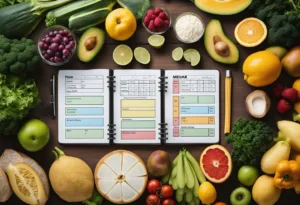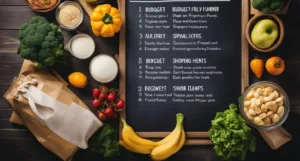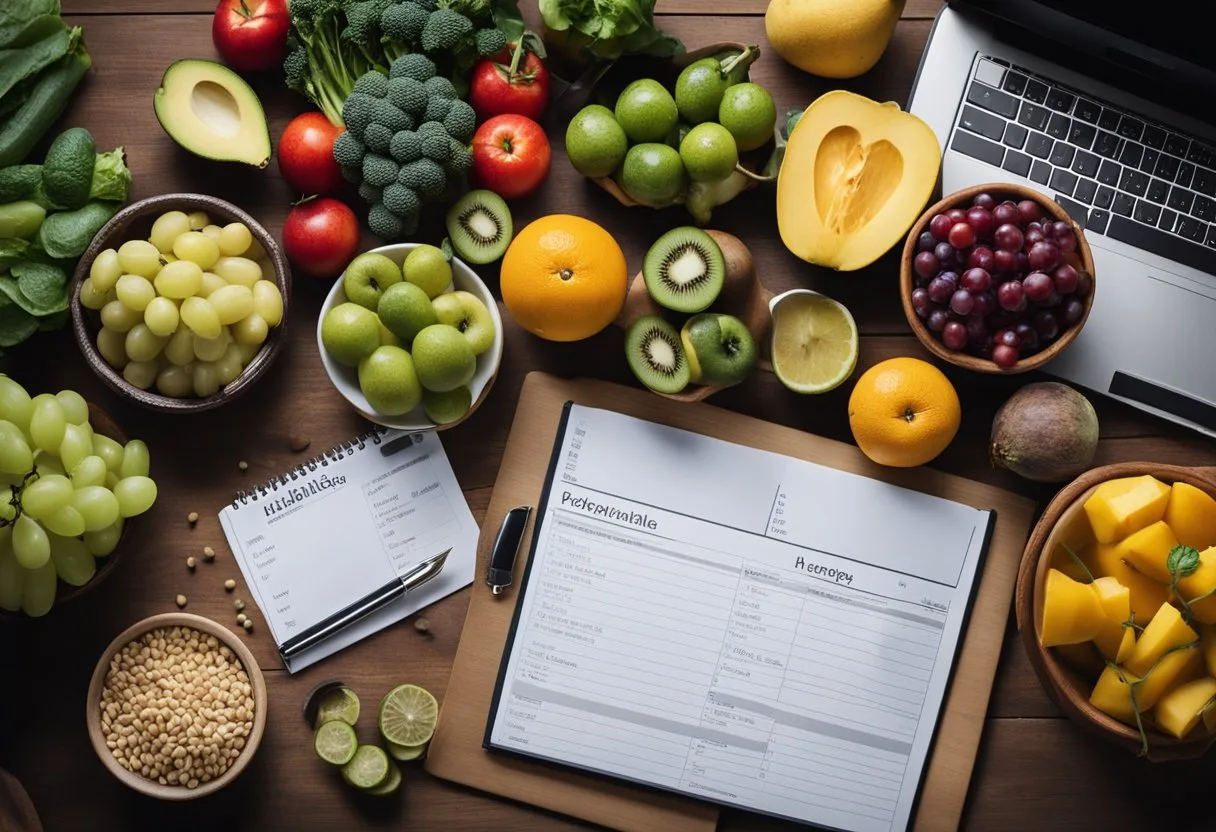Planning your grocery list and meal plan in advance can save you time, money, and stress. By creating a grocery planner, you can ensure that you have all the necessary ingredients for your meals and avoid the last-minute scramble to the grocery store. In this blog post I will provide step by step guide on how to use grocery planner and provide 25 grocery planner ideas to help you start.
There are many grocery planner ideas available, ranging from printable templates to smartphone apps. Some meal planning services even offer free weekly meal plans with accompanying shopping lists, taking the guesswork out of what to eat and what to buy. By utilizing these resources, you can streamline your grocery shopping and meal preparation process, making it easier to eat healthy and save money.
Creating Your Grocery Planner
When it comes to creating a grocery planner, there are several things to consider. A well-organized grocery planner can help you save time and money at the grocery store. In this section, we will discuss the essential components of a planner, choosing the right format, and integrating meal plans and shopping lists.
Choosing the Right Format
The first step in creating a grocery planner is to choose the right format. Many people prefer to use a printable grocery list template that they can fill out by hand. Others prefer to use an electronic format, such as a PDF format, that they can fill out on their computer or mobile device. Whichever format you choose, make sure it is easy to use and fits your needs.
Essential Components of a Planner
An effective grocery planner should include the essential components. These include a space to list the items you need to purchase, a space to note the quantity, and a space to indicate the price. You may also want to include a space to note the store or location where you can find the item.
Integrating Meal Plans and Shopping Lists
Integrating meal plans and shopping lists can help you save time and money. When creating your meal plan, consider what items you already have on hand and what items you need to purchase. Then, create your shopping list based on your meal plan. This will help you avoid buying unnecessary items and reduce food waste.
Creating a grocery planner is an essential step in saving time and money at the grocery store. By choosing the right format, including the essential components, and integrating meal plans and shopping lists, you can create an effective grocery planner that works for you.
How to use grocery planner effectively

To use a grocery planner effectively, follow this step-by-step guide in bullet points:
- Choose Your Format: Decide if you want a digital planner or a physical notebook.
- Set Up Your Layout: Create sections for days of the week, meals, and shopping lists.
- Plan Your Meals: Write down meal ideas for breakfast, lunch, dinner, and snacks for each day.
- Check Inventory: Look through your pantry, fridge, and freezer to see what ingredients you already have.
- List Needed Ingredients: Write down the ingredients needed for each meal that you don’t already have.
- Organize by Aisle: Group items by the store layout to make shopping more efficient.
- Estimate Quantities: Note how much of each item you need to prevent overbuying.
- Include Staples: Remember to include everyday items like milk, bread, and eggs.
- Consider Sales and Coupons: Check for deals and discounts before finalizing your list.
- Review and Revise: Go over your list to ensure you haven’t missed anything or added unnecessary items.
- Stick to Your List: When shopping, buy only what’s on your list to save money and reduce waste.
- Update as You Shop: Cross off items as you add them to your cart to keep track of what’s left.
- Plan for Leftovers: Consider meals that can be used for more than one day to save time and money.
- Be Flexible: Be prepared to make substitutions if items are out of stock or if you find better deals.
- Keep a Running List: Throughout the week, note items you run out of to add to your next grocery planner.
- Reflect and Adjust: After shopping, reflect on what worked and what didn’t to improve your next plan.
- Store Your Plans: Keep old planners for future inspiration and to quickly repeat successful weeks.
- Include Non-Food Items: Don’t forget household goods like toilet paper and cleaning supplies.
- Plan for Special Occasions: Adjust your planner for holidays, parties, or guests.
- Use Apps: Consider grocery planning apps that can sync with family members for shared shopping.
- Set a Budget: Before planning, decide on a budget to guide your meal choices and shopping.
- Meal Prep: Plan for meals that can be prepped ahead to save time during busy weeks.
- Seasonal Shopping: Plan meals around seasonal produce for freshness and cost savings.
- Health Focus: Plan with nutrition in mind, ensuring a balance of fruits, vegetables, proteins, and grains.
- Track Expenditures: Keep receipts and track spending to stay within budget and adjust future plans.
25 Grocery planner ideas
Here are 25 grocery planner ideas and how to start each idea:
- Weekly Meal Themes: Start by assigning a theme to each day, like Meatless Monday or Taco Tuesday.
- Seasonal Menus: Begin with a list of seasonal produce and build your meals around them.
- Diet-Specific Plans: Identify the diet or nutritional guidelines you’re following and plan meals that fit.
- Family Favorites: Compile a list of your family’s favorite meals and plan to rotate them.
- Batch Cooking: Plan to cook large quantities of a few dishes that can be eaten throughout the week.
- International Cuisine: Choose a different international cuisine for each week and explore new recipes.
- Vegetarian Planner: Start with a variety of plant-based protein sources to build your meals.
- Budget-Friendly Meals: Begin by setting a strict budget and looking for meals that are cost-effective.
- Quick and Easy Meals: List meals that take 30 minutes or less to prepare for busy days.
- Low-Carb Planner: Focus on meals that are high in protein and vegetables and low in carbohydrates.
- Kids’ Lunchbox Planner: Start with healthy, kid-friendly options that are easy to pack.
- Paleo Planner: Base your meals on whole foods, focusing on meats, vegetables, and nuts.
- Vegan Planner: Plan meals around legumes, grains, nuts, seeds, and plenty of fresh produce.
- Gluten-Free Planner: Begin by listing naturally gluten-free foods and finding suitable substitutes for others.
- Freezer Meal Planner: Plan meals that are freezer-friendly for easy heat-and-eat options.
- Organic Planner: Focus on meals that use primarily organic ingredients.
- Farmers’ Market Planner: Start by seeing what’s available at your local market and plan from there.
- High-Protein Planner: Center your meals around high-protein foods like meats, dairy, and legumes.
- Detox Planner: Plan meals that include detoxifying foods like leafy greens and citrus fruits.
- Soup and Salad Planner: Begin with a variety of soups and salads for lighter meal options.
- Smoothie Planner: Plan for different smoothie recipes, focusing on a variety of fruits and vegetables.
- Snack Planner: Create a section for healthy snacks to prevent impulse buys.
- Holiday Meal Planner: Start by listing the traditional dishes you want to include for the holiday.
- Pescatarian Planner: Focus on meals that include fish and seafood, along with vegetarian options.
- Low-Sodium Planner: Look for recipes that use herbs and spices for flavor instead of salt.
Strategies for Effective Meal Planning

Meal planning can be an excellent way to save time and money while ensuring that you and your family eat nutritious and delicious meals throughout the week. Here are some strategies to make your meal planning effective:
Crafting a Weekly Meal Plan
Crafting a weekly meal plan is an essential component of meal planning. It allows you to make a list of the ingredients you need and helps you avoid last-minute grocery store runs. When creating your weekly meal plan, consider your schedule for the week, your family’s dietary preferences and restrictions, and your budget.
One effective approach is to plan for a few meals that can be repurposed as leftovers or ingredients in other dishes. For example, if you plan to make roasted chicken for dinner on Monday, you can use the leftover chicken to make chicken tacos on Tuesday.
Incorporating Leftovers and Snacks
Incorporating leftovers and snacks into your meal plan can help you save time and reduce food waste. When planning your meals for the week, consider how you can repurpose leftovers into new dishes. For example, leftover grilled vegetables can be used in a salad or as a side dish for another meal.
Snacks can also be an important part of your meal plan, especially if you have children or a busy schedule. Plan for healthy snacks such as fruits, vegetables, and nuts to keep you and your family energized throughout the day.
Finding Inspiration and Variety
Finding inspiration and variety in your meal plan can help you avoid boredom and keep your taste buds happy. Consider incorporating your favorite recipes into your meal plan, and try new recipes to keep things interesting.
One effective way to find inspiration is to browse cookbooks, food blogs, and social media for new recipe ideas. You can also ask your family and friends for their favorite recipes or try new ingredients to add variety to your meals.
Meal planning can be an effective way to save time and money while ensuring that you and your family eat nutritious and delicious meals throughout the week. By crafting a weekly meal plan, incorporating leftovers and snacks, and finding inspiration and variety, you can make your meal planning effective and enjoyable.
Budget-Friendly Shopping Tips

When it comes to grocery shopping, there are many ways to save money without sacrificing quality. By following these budget-friendly shopping tips, shoppers can stretch their dollars further and make the most of their grocery budget.
Saving Money on Groceries
One of the most effective ways to save money on groceries is to plan ahead. By creating a grocery list and sticking to it, shoppers can avoid impulse purchases and only buy what they need. Shoppers can save money by buying in bulk, opting for generic brands, and choosing frozen or canned produce when fresh produce is not in season.
Another way to save money on groceries is to shop at farmers markets. Not only do farmers markets offer fresh, locally grown produce, but they often have lower prices than grocery stores. Shopping at farmers markets also supports local farmers and the local economy.
Utilizing Coupons and Deals
Another way to save money on groceries is to utilize coupons and deals. Many grocery stores offer weekly sales and discounts, which can be found in weekly ads or online. Shoppers can also find coupons online or in newspapers and magazines. By combining coupons with sales, shoppers can save even more money on their grocery bill.
Planning Around Sales and Seasons
Planning meals around sales and seasons is another effective way to save money on groceries. By buying produce when it is in season, shoppers can take advantage of lower prices and better quality. For example, in May, shoppers can find deals on strawberries, while in July, they can find deals on watermelon.
Shoppers can also plan meals around weekly sales and discounts. By checking weekly ads and planning meals accordingly, shoppers can save money on their grocery bill while still enjoying delicious and nutritious meals.
There are many ways to save money on groceries without sacrificing quality. By following these budget-friendly shopping tips, shoppers can make the most of their grocery budget and save money in the process.
Efficient Grocery Shopping and Food Storage

Organizing Your Shopping Trip
Efficient grocery shopping starts with proper planning. Creating a master grocery list of all the items you regularly buy can save time and reduce stress. You can reference it every time you make your shopping list, to make sure you don’t forget anything. It’s also a huge time-saver! Keep a running list of things you need throughout the week so you can add them to your list as needed.
Another tip for efficient grocery shopping is to shop during off-peak hours. This means avoiding weekends and evenings when the store is crowded. Shopping during off-peak hours can save time and make your shopping experience more pleasant.
Properly Storing Groceries to Reduce Waste
Properly storing groceries is essential to reduce food waste. Make sure to store food in the right place to keep it fresh for longer. For example, keep fruits and vegetables in the crisper drawer of the fridge, and store meat on the bottom shelf to prevent cross-contamination.
It’s important to check expiration dates and use food before it goes bad. Create a meal plan for the week to use up all the food you buy. This can also help save money by reducing the amount of food that goes to waste.
Making the Most of Pantry and Freezer Space
To make the most of pantry and freezer space, organize your food by category and label everything clearly. This will help you find what you need quickly and prevent food from going bad. When storing food in the freezer, make sure to use airtight containers or freezer bags to prevent freezer burn. Label everything with the date so you know how long it’s been in the freezer.
Finally, keep staple items on hand in the pantry, such as canned goods, pasta, rice, and beans. These items have a long shelf life and can be used in a variety of recipes. Keeping a well-stocked pantry can save time and money by reducing the number of trips to the grocery store.
Frequently Asked Questions
What are the essential items to include in a budget-friendly grocery list?
When creating a budget-friendly grocery list, it is important to focus on the essentials. This includes items such as fresh produce, whole grains, lean proteins, and healthy fats. By prioritizing these items, you can ensure that you are getting the nutrients you need without breaking the bank.
How can I effectively plan meals for a family over the course of a week?
To effectively plan meals for a family over the course of a week, it is important to take into account everyone’s preferences and dietary needs. Start by creating a list of family favorites and then build your meal plan around those dishes. Consider incorporating a variety of proteins, vegetables, and grains to ensure a balanced diet.
What is the best way to organize a grocery list to save time and money?
Organizing your grocery list by category can save both time and money. Consider grouping items together by department, such as produce, dairy, and meat. This can help you quickly navigate the store and avoid backtracking. Consider adding a section for sale items or coupons to help you save money on your purchases.
What strategies can I use to create a 7-day meal plan with an accompanying shopping list?
To create a 7-day meal plan with an accompanying shopping list, start by choosing your meals for the week. Consider incorporating leftovers and meals that can be repurposed to save time and money. Once you have your meals planned out, create a shopping list based on the ingredients needed for each recipe.
Can you suggest a method for meal planning that accommodates a family’s diverse tastes and dietary needs?
When accommodating a family’s diverse tastes and dietary needs, it can be helpful to create a meal plan that allows for customization. Consider creating meals with a variety of options, such as a taco bar or pasta station, that allow each family member to choose their own ingredients. Consider incorporating vegetarian or gluten-free options to accommodate dietary restrictions.
How does the 5 4 3 2 1 grocery shopping strategy work for simplifying meal planning?
The 5 4 3 2 1 grocery shopping strategy involves purchasing 5 servings of fruits and vegetables, 4 servings of protein, 3 servings of whole grains, 2 servings of dairy, and 1 serving of a healthy fat. By following this strategy, you can ensure that you are getting a balanced diet while simplifying your meal planning and grocery shopping.




